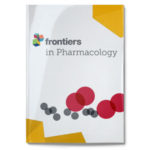
АТФ-связывающий кассетный транспортер G2 (ABCG2) — белок цитоплазматической мембраны, который регулирует фармакокинетику различных препаратов и уровень мочевой кислоты в сыворотке (МКС) у человека. Несмотря на фармакологическое и физиологическое значение этого транспортера, в настоящее время нет препаратов для медицинского применения, которые бы влияли на работу ABCG2. Чтобы найти такие препараты, мы изучили влияние на работу ABCG2 препаратов, которые изменяют уровень МКС. В основе такой стратегии лежала гипотеза о том, что изменение уровня МКС может быть вызвано взаимодействием с ABCG2, поскольку это значимый транспортер уратов. Скрининг in vitro показал, что 10 из 25 изученных препаратов оказывали сильное влияние на транспорт уратов посредством ABCG2. Наиболее перспективным кандидатом из всех потенциальных ингибиторов ABCG2 оказался фебуксостат, поскольку он оказывал сильное ингибирующее действие в концентрациях, используемых в клинической практике; концентрация полумаксимального ингибирования фебуксостата была ниже, чем известная максимальная концентрация его в плазме в форме, не связанной с белками. Наше исследование in vivo показало, что при приеме внутрь фебуксостат ингибировал Abcg2 кишечника и, следовательно, усиливал всасывание сульфасазалина, субстрата ABCG2 в кишечнике мышей дикого типа, но не у мышей с нокаутом Abcg2. Эти данные позволяют предположить, что фебусостат в клинических дозах может ингибировать ABCG2 у человека. Кроме того, результаты этого исследования позволяют говорить о потенциальном применении фебуксостата для повышения биодоступности препаратов-субстратов ABCG2 — так называемая терапия, потенциированная фебуксостатом. Также существует потенциальный риск побочного действия вследствие взаимодействия между фебуксостатом и препаратами-субстратами ABCG2.
Miyata H1, Takada T1, Toyoda Y1, Matsuo H2, Ichida K3, Suzuki H1.
Frontiers in Pharmacology. 2016 Dec.
Ссылка на DOI
![]()
Identification of Febuxostat as a New Strong ABCG2 Inhibitor: Potential Applications and Risks in Clinical Situations
Abstract
ATP-binding cassette transporter G2 (ABCG2) is a plasma membrane protein that regulates the pharmacokinetics of a variety of drugs and serum uric acid (SUA) levels in humans. Despite the pharmacological and physiological importance of this transporter, there is no clinically available drug that modulates ABCG2 function. Therefore, to identify such drugs, we investigated the effect of drugs that affect SUA levels on ABCG2 function. This strategy was based on the hypothesis that the changes of SUA levels might caused by interaction with ABCG2 since it is a physiologically important urate transporter. The results of the in vitro screening showed that 10 of 25 drugs investigated strongly inhibited the urate transport activity of ABCG2. Moreover, febuxostat was revealed to be the most promising candidate of all the potential ABCG2 inhibitors based on its potent inhibition at clinical concentrations; the half-maximal inhibitory concentration of febuxostat was lower than its maximum plasma unbound concentrations reported. Indeed, our in vivo study demonstrated that orally administered febuxostat inhibited the intestinal Abcg2 and, thereby, increased the intestinal absorption of an ABCG2 substrate sulfasalazine in wild-type mice, but not in Abcg2 knockout mice. These results suggest that febuxostat might inhibit human ABCG2 at a clinical dose. Furthermore, the results of this study lead to a proposed new application of febuxostat for enhancing the bioavailability of ABCG2 substrate drugs, named febuxostat-boosted therapy, and also imply the potential risk of adverse effects by drug-drug interactions that could occur between febuxostat and ABCG2 substrate drugs.
KEYWORDS
BCRP; URAT1; allopurinol; benzbromarone; bioavailability; drug repositioning; drug-drug interactions; topiroxostat
Table 1
List of SUA-affecting drugs in the present study.
| Effect on SUA levels | Drugs | Maximum concentration in the present study [μM] | References |
|---|---|---|---|
| I Decrease expectedly | Allopurinol | 300 | Watts et al., 1965 |
| Benzbromarone | 100 | Enomoto et al., 2002 | |
| Febuxostat | 10 | Osada et al., 1993 | |
| Oxypurinol | 100 | Watts et al., 1965 | |
| Probenecid | 100 | Gutman et al., 1954 | |
| Topiroxostat | 3 | Okamoto et al., 2003 | |
| II Decrease unexpectedly | Atorvastatin∗ | 30 | Ogata et al., 2010 |
| Fenofibrate | 300 | Harvengt et al., 1980 | |
| Losartan | 300 | Kamper and Nielsen, 2001 | |
| Rosuvastatin∗ | 100 | Ogata et al., 2010 | |
| III Increase unexpectedly | Chlorothiazide | 300 | Kelley et al., 1973 |
| Cyclosporine∗ | 30 | Palestine et al., 1984 | |
| Ethambutol | 1000 | Postlethwaite et al., 1972 | |
| Fructose | 1000 | Thomas et al., 1975 | |
| Furosemide | 300 | Kelley et al., 1973 | |
| Hydrochlorothiazide | 1000 | Healey et al., 1959 | |
| Mizoribine | 300 | Ishikawa et al., 1986 | |
| Nicotinic acid | 300 | Cruess-Callaghan and FitzGerald, 1966 | |
| Pyrazinamide | 300 | Cullen et al., 1956 | |
| Pyrazinecarboxylic acid | 1000 | Cullen et al., 1956 | |
| Ribavirin | 1000 | Yamashita et al., 2008 | |
| Salicylic acid | 1000 | Yu and Gutman, 1959 | |
| Tacrolimus∗ | 30 | Kanbay et al., 2005 | |
| Theophylline | 100 | Yamamoto et al., 1991 | |
| Xylitol | 1000 | Thomas et al., 1975 |
FIGURE 1
Effect of serum uric acid (SUA)-affecting drugs on the urate transport activity of ABCG2. (A) Expression of ABCG2 on membrane vesicles. Membrane vesicles (5 μg) were subjected to western blot analysis using a BXP-21, an anti-ABCG2 or anti-Na+ …

